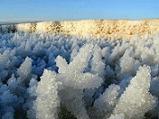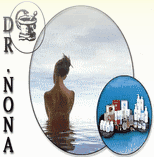
The Dead Sea Water
The Dead Sea is the richest source of minerals and microelements that are in the water and the mineral mud.
Over thousands of years thermo-mineral springs filled the Dead Sea. Under the heat of the sun, the water evaporated
and minerals sunk and accumulated. That is the reason why the salts' concentration in the Dead Sea is 10 times
higher than in other seas and oceans. Comparison between the chemical composition of the Dead Sea to other lakes
and oceans show that the salt's concentration in the Dead Sea is 31.5% (from: "Some Geo-Chemical Aspects of the
Dead Sea and its Age", 1991, Ya'akov Ben-Tur). The concentration of SO4 ions is very low, and the bromine ions'
concentration is the highest of all waters on earth. Chlorides neutralize most of the calcium ions in the Dead Sea and
its surroundings. While in other seas NaCl is 97%, in the Dead Sea the quantity of the NaCl is only 12-18 percent.
The remaining part is composed of Potassium, Magnesium, Bromide and others. The water temperature goes from
19 degrees Celsius in February to 31 degrees Celsius in August.
There is Life in the Dead Sea!
In 1936, Dr. Vikinsky has discovered the bacteria in water samples which were taken 3-4 km from the mouth of the
Jordan, from different depths (up to 7 m), and in general concentration of mineral - about 27%. The development of
the microbiological and biological of the Dead Sea is linked to the activity of Mr. Benjamin Elazari-Volcani. In his
doctorate ("Research of Micro-flora of the Dead Sea", the Hebrew University, Jerusalem, 1940), the micro-flora of
the Dead Sea is described and identified for the first time. Except for bacteria concentration of 4-5 X 104 cells in
milliliter water, A. Oren grew in 1983, in the water of the Dead Sea, a very small quantity of marine alga (Dunaliela)
(4-6 cells in milliliter). Based on these data arch bacteria were added to the "Bacteria Diagnosis" guide (the term
appears in B. Alberts, D. Bray, J. Lewis, M. Raff et al, "Molecular Biology of the Cell", Vol. 1. Mir Publishers, 1994).
The arch bacteria are registered as Halo bacterium type according to the following groups:
Halobacterium salinarium
Halbacterium citirubrum
Halbacterium nalobium
Halbacterium marismortui
Halbacterium trapanicum
<<
>>
Language




